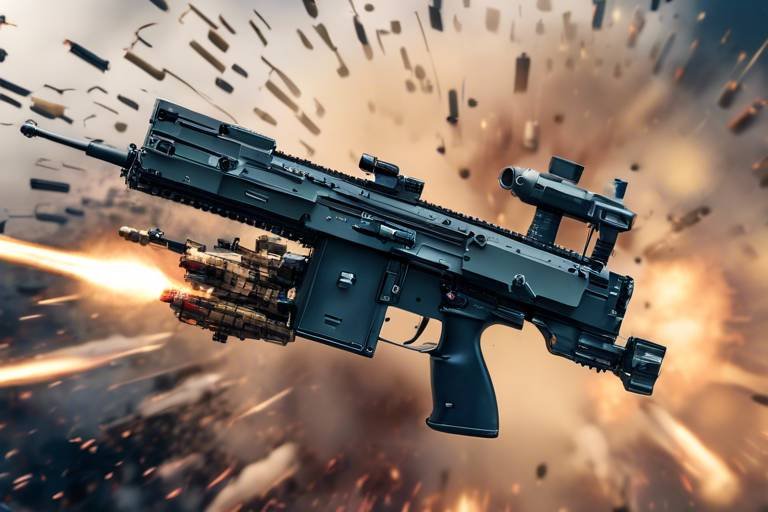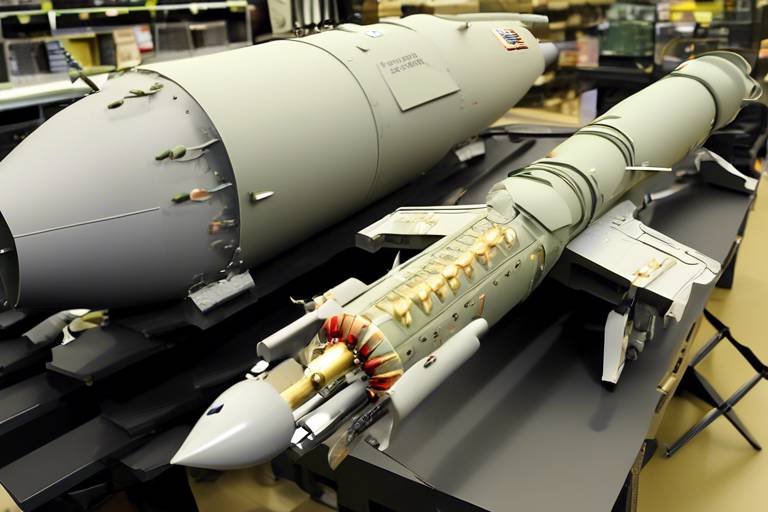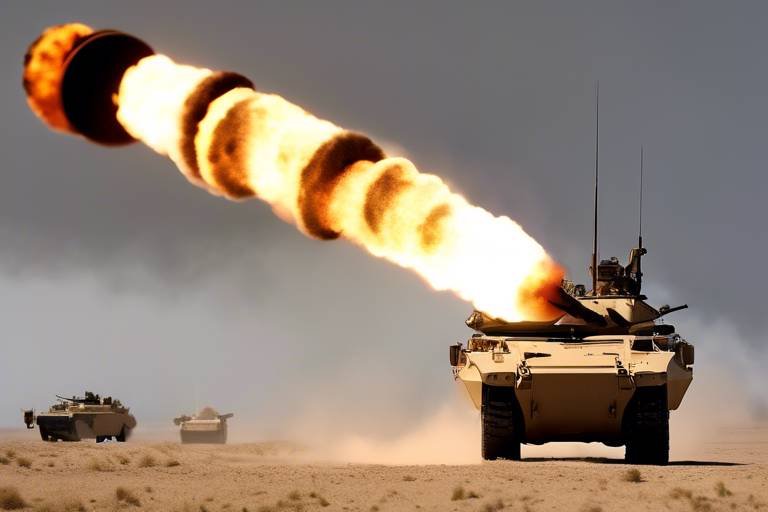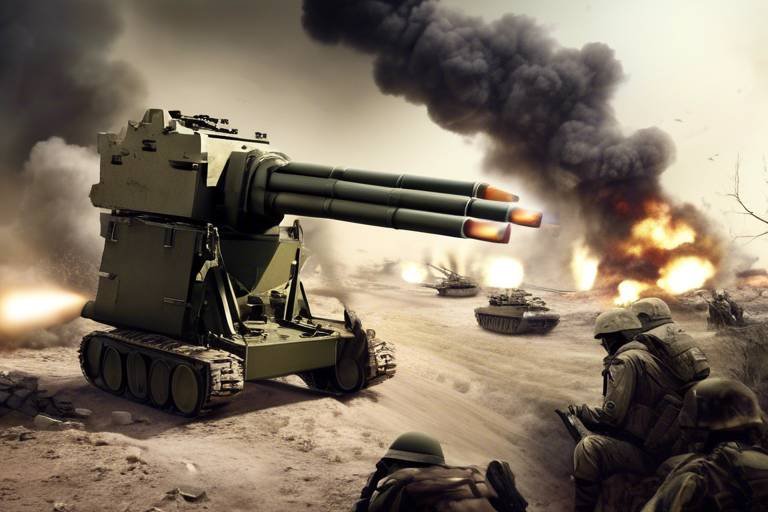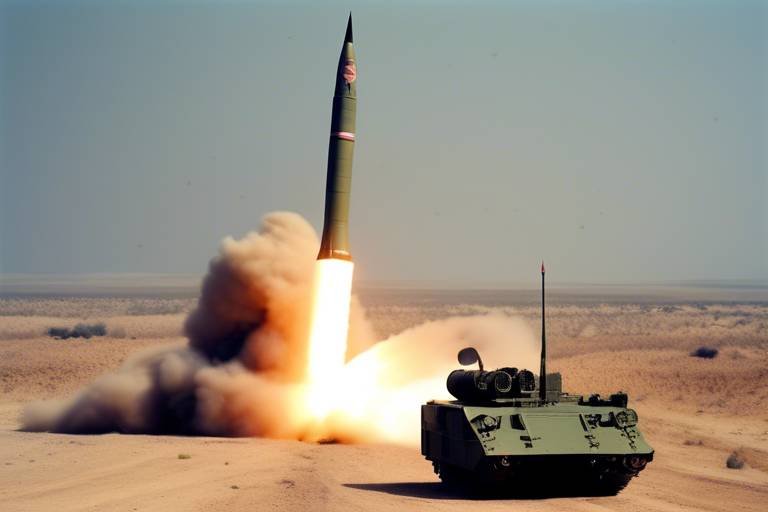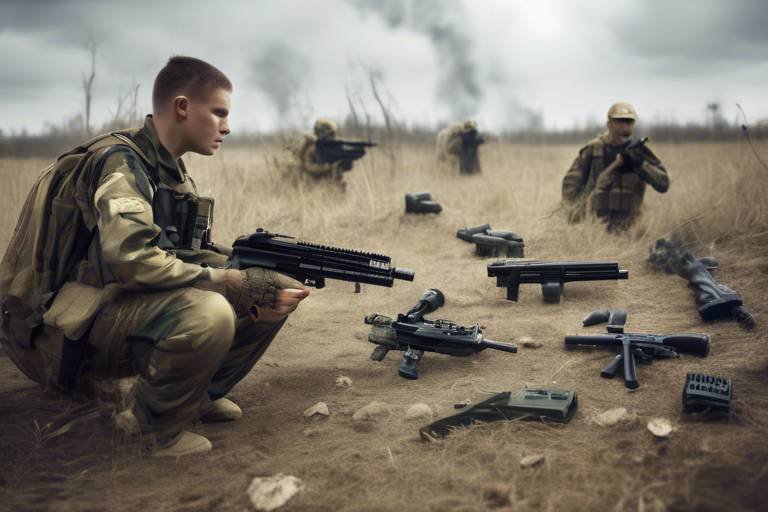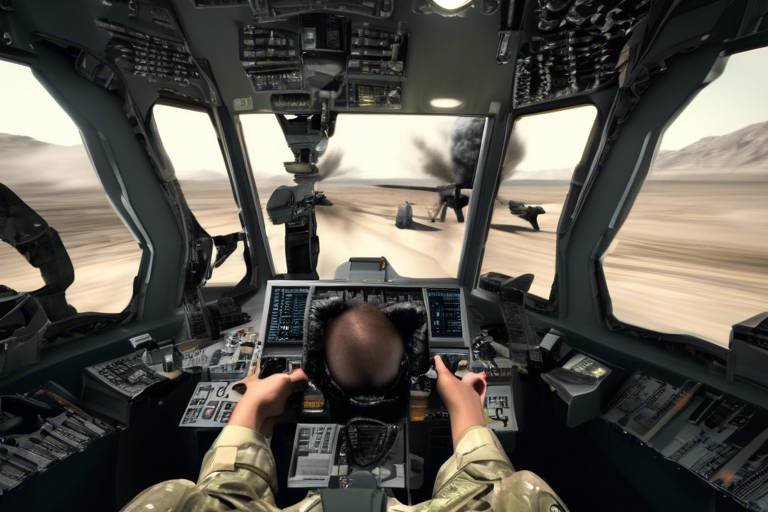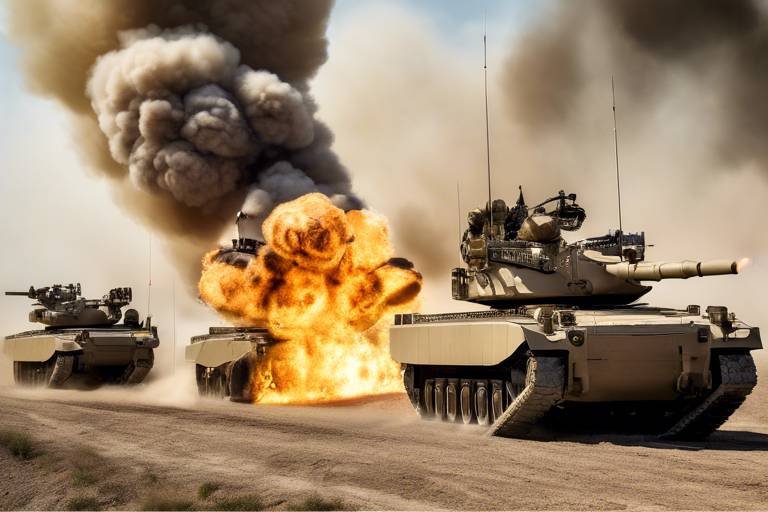Exploring the Integration of AI in Weapon Systems
The landscape of modern warfare is undergoing a profound transformation, driven largely by the integration of artificial intelligence (AI) into weapon systems. This article delves into the multifaceted role that AI plays in reshaping military strategies, enhancing operational efficiency, and posing ethical dilemmas. As we embark on this exploration, it’s important to consider how AI not only changes the way wars are fought but also influences global security dynamics.
Imagine a battlefield where decisions are made in milliseconds, where drones can autonomously navigate complex environments, and where data analytics provide real-time insights to commanders. This is not a scene from a futuristic sci-fi movie; it’s rapidly becoming a reality. The integration of AI in weapon systems signifies a shift from traditional combat methods to a new era of warfare characterized by speed, precision, and, unfortunately, ethical quandaries.
Throughout history, military innovations have often been driven by technological advancements. From the invention of gunpowder to the development of nuclear weapons, each leap forward has changed the nature of conflict. Today, AI stands at the forefront of this evolution, offering capabilities that were once thought to be the realm of fiction. But as we harness these powerful tools, we must also grapple with the implications they bring.
AI technologies are not just about making weapons smarter; they are about redefining the very nature of combat. For instance, autonomous drones equipped with AI can conduct surveillance and strike missions without direct human intervention, leading to questions about accountability and ethical use. Moreover, the potential for AI to enhance decision-making processes means that military leaders can analyze vast amounts of data to make informed choices, potentially changing the outcome of engagements.
As we navigate this complex terrain, it’s crucial to examine the benefits and challenges that come with AI integration in weapon systems. On one hand, AI can increase operational efficiency and situational awareness, allowing military forces to respond swiftly to threats. On the other hand, the risks associated with autonomous warfare raise significant ethical concerns that cannot be overlooked.
In the following sections, we will explore the historical evolution of AI in military applications, current technologies being utilized, the benefits and challenges of these innovations, and the ethical implications that arise from their use. By understanding these facets, we can better appreciate the transformative power of AI in weapon systems and prepare for the future of warfare.
- What is the role of AI in modern weapon systems? AI enhances decision-making, improves precision, and increases operational efficiency in military operations.
- Are there ethical concerns with AI in warfare? Yes, there are significant ethical dilemmas regarding accountability, the potential for misuse, and the need for human oversight.
- How does AI change military strategy? AI allows for faster and more informed decision-making, potentially altering the dynamics of conflict and military engagements.
- What are some examples of AI technologies in weapon systems? Examples include autonomous drones, smart munitions, and advanced data analytics tools.
- What are the risks of integrating AI into weapon systems? Risks include ethical dilemmas, accountability issues, and the potential for autonomous warfare without human intervention.
The Evolution of AI in Military Applications
Artificial Intelligence (AI) has come a long way since its inception, evolving from theoretical concepts into powerful tools that reshape military applications. The journey began in the mid-20th century, when early computer scientists and mathematicians started to explore the potential of machines to simulate human intelligence. The initial focus was on problem-solving and logical reasoning, laying the groundwork for the complex algorithms we see today.
Fast forward to the 1980s and 1990s, and we witness the emergence of expert systems designed to assist military strategists in decision-making processes. These systems were primitive by today’s standards, yet they represented a significant leap forward, enabling military planners to analyze data and predict outcomes more efficiently. The Gulf War of 1991 served as a pivotal moment, showcasing how technology could enhance military operations. The use of precision-guided munitions and advanced reconnaissance systems marked the beginning of a new era.
As technology advanced, so did the capabilities of AI in military contexts. The early 2000s saw the introduction of machine learning, allowing systems to learn from data and improve over time. This period also witnessed the rise of unmanned aerial vehicles (UAVs), or drones, which began to play a crucial role in surveillance and combat. Drones equipped with AI capabilities could autonomously navigate, identify targets, and even engage in combat without direct human intervention. This shift raised significant questions about the nature of warfare and the ethical implications of using machines in life-and-death scenarios.
The integration of AI into military applications has continued to accelerate, particularly in the last decade. Today, we see sophisticated AI technologies being employed in various domains, including:
- Autonomous Systems: Drones and ground vehicles that can operate independently.
- Smart Munitions: Weapons that can adjust their trajectory in real-time to hit moving targets.
- Data Analytics: AI systems that analyze vast amounts of data for actionable intelligence.
These advancements have not only transformed operational capabilities but also redefined military strategy. Commanders can now leverage AI for predictive analysis, enhancing situational awareness and enabling quicker decision-making on the battlefield. The rapid evolution of AI in military applications raises critical questions about the future of warfare, including the balance of power among nations and the ethical dilemmas posed by autonomous weapon systems.
In summary, the evolution of AI in military applications reflects a trajectory of innovation and adaptation. From early computational theories to the sophisticated systems of today, AI has become an integral part of military strategy. As we look to the future, it is essential to consider the implications of these technologies, not just for military effectiveness but for global security and ethical governance.
Current AI Technologies in Weapon Systems
Artificial Intelligence (AI) has become a game-changer in the realm of military technology, revolutionizing the way armed forces operate on the battlefield. Today, various cutting-edge AI technologies are being integrated into weapon systems, enhancing their capabilities and effectiveness. From autonomous drones to smart munitions, these innovations are reshaping military strategies and tactics.
One of the most notable advancements in AI weaponry is the development of autonomous drones. These unmanned aerial vehicles (UAVs) can operate without direct human control, utilizing sophisticated algorithms to navigate, identify targets, and execute missions. Imagine a bird of prey soaring through the sky, scanning the ground for its next meal; that's how these drones function, but with the added precision of AI. They can analyze vast amounts of data in real-time, allowing for rapid decision-making that is crucial in combat situations.
Another significant innovation is the emergence of smart munitions. These are guided weapons equipped with AI systems that enhance their accuracy and effectiveness. Unlike traditional munitions that rely solely on ballistic trajectories, smart munitions can adjust their flight paths mid-air based on real-time data. This capability is akin to a skilled archer adjusting their aim based on the wind's direction and speed, leading to a much higher probability of hitting the intended target. The integration of AI into these systems not only increases the likelihood of success but also minimizes collateral damage, which is a significant concern in modern warfare.
Moreover, AI is playing a crucial role in data analytics for military operations. Through machine learning algorithms, military forces can process and analyze vast amounts of data from various sources, such as satellite imagery, reconnaissance reports, and intelligence communications. This data-driven approach enhances situation awareness, allowing commanders to make informed decisions quickly. Picture a chess player who can see several moves ahead; that’s how military leaders can strategize using AI-enhanced analytics.
| AI Technology | Description | Benefits |
|---|---|---|
| Autonomous Drones | Unmanned aerial vehicles capable of independent operation. | Increased surveillance, rapid response, and reduced risk to personnel. |
| Smart Munitions | Guided weapons that can alter their flight path using AI. | Higher accuracy, reduced collateral damage, and improved mission success rates. |
| Data Analytics | AI systems that analyze and interpret large datasets. | Enhanced situational awareness and faster decision-making capabilities. |
As we delve deeper into the integration of AI technologies in weapon systems, it's vital to recognize that these advancements are not without their challenges. While they offer significant advantages, they also raise questions about ethics, accountability, and the potential for misuse. Nevertheless, the ongoing evolution of AI in military applications suggests that we are only scratching the surface of what is possible.
In conclusion, the current landscape of AI technologies in weapon systems is rich with innovation and potential. As these technologies continue to develop, they promise to reshape the future of warfare, offering unprecedented capabilities and efficiencies. However, it is essential for military leaders and policymakers to navigate the complexities of this new frontier responsibly, ensuring that the integration of AI serves to enhance, rather than undermine, global security.
- What are autonomous drones? Autonomous drones are unmanned aerial vehicles that operate independently using AI algorithms for navigation and target identification.
- How do smart munitions work? Smart munitions are guided weapons that can adjust their flight paths mid-air based on real-time data, increasing their accuracy.
- What role does data analytics play in military operations? Data analytics powered by AI helps military forces process large datasets to enhance situational awareness and decision-making.
Benefits of AI Integration in Warfare
The integration of artificial intelligence (AI) in warfare has revolutionized military operations, offering a plethora of benefits that enhance effectiveness and efficiency on the battlefield. One of the most significant advantages is the increased operational efficiency that AI brings to the table. Imagine a battlefield where decisions are made in real-time, with data analyzed and interpreted at lightning speed. This capability allows military strategists to respond swiftly to evolving situations, ensuring that troops are always one step ahead of adversaries.
Moreover, AI technologies enhance precision in targeting and engagement. Traditional weapon systems often rely on human judgment, which can be fallible under pressure. In contrast, AI can process vast amounts of data from various sources, including satellite imagery and reconnaissance, to identify targets with remarkable accuracy. This not only minimizes collateral damage but also increases the likelihood of mission success. For instance, AI-driven smart munitions can adjust their trajectories mid-flight, ensuring they hit their intended targets even in dynamic environments.
Another critical benefit of AI integration is the improved situational awareness it provides. In modern warfare, the ability to understand the operational environment is paramount. AI systems can aggregate and analyze data from multiple sensors and platforms, offering commanders a comprehensive view of the battlefield. This enhanced awareness enables better decision-making and resource allocation, ultimately leading to more effective military operations. For example, AI can help identify patterns in enemy movements, allowing forces to anticipate actions and plan accordingly.
Furthermore, the use of AI in logistics and supply chain management can significantly streamline military operations. AI algorithms can predict equipment needs, optimize supply routes, and even manage inventory levels, ensuring that troops have the necessary resources at their disposal when they need them. This efficiency not only saves time and money but also enhances the overall readiness of military forces.
However, it’s important to note that while the benefits of AI in warfare are substantial, they come with their own set of challenges and ethical considerations. The reliance on AI systems raises questions about accountability and the potential for unintended consequences. As we embrace these advanced technologies, it is crucial to strike a balance between leveraging their advantages and addressing the accompanying risks.
- What are the primary benefits of AI in military operations? AI enhances operational efficiency, precision in targeting, situational awareness, and logistics management.
- How does AI improve decision-making on the battlefield? AI processes vast amounts of data quickly, providing commanders with real-time insights and predictive analytics.
- Are there risks associated with AI in warfare? Yes, risks include ethical dilemmas, accountability issues, and potential misuse of autonomous systems.
Challenges and Risks of AI in Weapons
The integration of artificial intelligence into weapon systems is not without its challenges and risks. As we stand on the brink of a new era in military technology, it’s crucial to scrutinize the potential pitfalls that accompany this powerful innovation. One of the most pressing concerns is the ethical dilemma surrounding the use of autonomous weapons. Imagine a scenario where machines make life-and-death decisions without human intervention. This raises the question: who is responsible when something goes wrong? The absence of accountability can lead to devastating consequences, both on the battlefield and beyond.
Moreover, the risk of malfunction or hacking cannot be overlooked. AI systems, while advanced, are still susceptible to technical failures or cyber-attacks. For instance, if a drone programmed to identify and engage targets were to be compromised, it could result in catastrophic outcomes, potentially targeting civilians instead of military objectives. This unpredictability leads to a significant erosion of trust in AI-driven systems.
Another challenge is the potential for an arms race in autonomous weaponry. As nations rush to develop and deploy AI technologies, there is a risk of escalating tensions and conflicts. The more countries invest in these systems, the more likely it is that they will be used in combat, leading to a cycle of violence that could spiral out of control. This scenario can be likened to a game of chess, where each move could provoke a counter-move, escalating the stakes to a point of no return.
Furthermore, the ethical implications of AI in warfare extend to the broader societal context. The normalization of autonomous weapons could desensitize the public to the realities of war. When decisions about life and death are made by algorithms, it may lead to a perception that warfare is a video game, devoid of the human suffering that accompanies traditional combat. This detachment from the human aspect of warfare poses a significant moral challenge.
To illustrate these challenges more clearly, consider the following table summarizing key risks associated with AI in weapon systems:
| Risk | Description |
|---|---|
| Ethical Dilemmas | Questions of accountability and moral responsibility in autonomous decision-making. |
| Technical Failures | Potential for malfunction or errors leading to unintended consequences. |
| Cyber Vulnerabilities | Risk of hacking or manipulation of AI systems by malicious actors. |
| Escalation of Conflict | Increased likelihood of arms races and rapid military escalation. |
| Desensitization | Normalization of warfare through automated systems, leading to societal detachment from the consequences of combat. |
In summary, while the integration of AI into weapon systems offers remarkable advancements, it also presents a myriad of challenges and risks that cannot be ignored. Addressing these concerns requires a careful, balanced approach that prioritizes ethical considerations and human oversight. As we navigate this complex landscape, it’s essential to engage in ongoing discussions about the implications of AI in warfare, ensuring that technological advancements do not outpace our moral and ethical frameworks.
- What are the main ethical concerns regarding AI in weapons?
The primary concerns include accountability for decisions made by autonomous systems, the potential for misuse, and the moral implications of delegating lethal force to machines. - Can AI systems malfunction in combat?
Yes, AI systems can experience technical failures, which may lead to unintended consequences or misidentification of targets. - How does AI in weapons affect international relations?
The development of AI weaponry can lead to an arms race, increasing tensions between nations and potentially escalating conflicts. - What measures are in place to regulate AI in military applications?
Various international treaties and discussions aim to establish guidelines and regulations governing the use of AI in weapon systems, though enforcement remains a challenge.
International Regulations and AI in Arms
The integration of artificial intelligence in weapon systems has sparked a significant debate among policymakers, military leaders, and ethicists worldwide. As AI technologies become more sophisticated, the need for comprehensive international regulations becomes increasingly urgent. The challenge lies in balancing technological advancement with ethical considerations and global security. Many countries are grappling with how to regulate these emerging technologies while ensuring that they do not contribute to an arms race or exacerbate existing tensions.
Currently, there are several international treaties and agreements that provide a framework for arms control, but they often lack specific provisions addressing AI. For instance, the United Nations Convention on Certain Conventional Weapons (CCW) has been a platform for discussions regarding lethal autonomous weapons systems (LAWS). However, the conversations surrounding AI in arms are still in their infancy. Many countries are hesitant to impose strict regulations, fearing that doing so might hinder their military capabilities and technological advancements.
To better understand the landscape of international regulations regarding AI in arms, it's helpful to look at the following key treaties and initiatives:
| Treaty/Initiative | Description | Current Status |
|---|---|---|
| United Nations CCW | A forum for discussing the humanitarian impacts of certain conventional weapons, including autonomous weapons. | Ongoing discussions, no binding regulations yet. |
| Arms Trade Treaty (ATT) | Regulates international trade in conventional arms, aiming to prevent and eradicate illicit arms trafficking. | In force, but lacks specific provisions for AI technologies. |
| European Union's AI Act | A proposed regulation aimed at ensuring ethical AI development and deployment, including military applications. | In draft stage, not yet implemented. |
In addition to these treaties, various non-governmental organizations and advocacy groups are pushing for stronger regulations on the use of AI in military applications. They argue that without a robust regulatory framework, the risk of misuse and unintended consequences will grow. These organizations emphasize the need for transparency, accountability, and human oversight in the deployment of AI-enabled weapon systems.
Moreover, the concept of a “killer robot” ban has gained traction in international discussions. Advocates for this ban argue that fully autonomous weapons systems could operate without human intervention, raising profound ethical and moral questions. The potential for such weapons to make life-and-death decisions without human oversight is alarming and has led to calls for a preemptive ban on their development and use.
As nations navigate the complexities of regulating AI in arms, the importance of international cooperation cannot be overstated. It is crucial for countries to engage in dialogue, share best practices, and establish common standards to mitigate the risks associated with AI in military applications. Only through collaborative efforts can we hope to create a secure and stable global environment where technological advancements do not come at the expense of humanity’s safety and ethical standards.
- What is the current state of international regulations on AI weapons?
There are ongoing discussions, but no binding regulations specifically addressing AI in arms have been established yet. - Are there any treaties that govern the use of AI in military applications?
The United Nations CCW and the Arms Trade Treaty provide some framework, but they lack specific provisions for AI technologies. - What ethical concerns are associated with AI in weapon systems?
Ethical concerns include the potential for autonomous decision-making in lethal situations, accountability issues, and the risk of misuse.
Case Studies of AI-Enabled Weapon Systems
The integration of artificial intelligence into weapon systems is not just a theoretical concept; it has manifested in various real-world applications that are reshaping military operations. One of the most notable examples is the use of autonomous drones in modern warfare. These drones, equipped with advanced AI algorithms, can independently navigate complex environments, identify targets, and execute missions without direct human intervention. For instance, the U.S. military's MQ-9 Reaper drone has been pivotal in conducting surveillance and targeted strikes, showcasing the effectiveness of AI in enhancing operational capabilities.
Another significant case study is the deployment of smart munitions, such as the Joint Direct Attack Munition (JDAM). This system transforms unguided bombs into precision-guided munitions by utilizing GPS and AI for real-time target acquisition and trajectory adjustments. The JDAM has revolutionized airstrikes, allowing for a dramatic increase in accuracy while minimizing collateral damage. This capability is especially crucial in urban warfare scenarios, where distinguishing between combatants and civilians is paramount.
In addition to drones and smart munitions, AI-driven data analytics has become an essential tool for military strategists. By analyzing vast amounts of battlefield data, AI systems can provide insights that enhance decision-making processes. For example, the U.S. Army's Project Convergence utilizes AI to integrate data from various sources, including satellite imagery and ground intelligence, to create a comprehensive operational picture. This capability not only improves situational awareness but also accelerates the decision-making cycle, enabling faster and more effective responses to emerging threats.
Internationally, countries like Israel have also made significant strides in AI-enabled weapon systems. The Iron Dome missile defense system, which employs AI algorithms to predict and intercept incoming threats, has demonstrated remarkable success in protecting civilian areas from rocket attacks. This system exemplifies how AI can be harnessed not just for offensive capabilities but also for defensive measures, highlighting a balanced approach to modern warfare.
While these case studies illustrate the transformative potential of AI in weapon systems, they also raise critical questions about the future of warfare. The effectiveness of these technologies depends not only on their technical capabilities but also on the ethical frameworks and international regulations guiding their use. As military forces around the globe continue to invest in AI, understanding the implications of these advancements is essential for ensuring responsible and accountable deployment.
- What are AI-enabled weapon systems? AI-enabled weapon systems are military technologies that incorporate artificial intelligence to enhance their operational capabilities, including autonomous drones, smart munitions, and advanced data analytics.
- How do autonomous drones work? Autonomous drones use AI algorithms to navigate, identify targets, and execute missions independently, often without direct human control.
- What is the significance of smart munitions? Smart munitions, such as JDAMs, enhance the precision of airstrikes by utilizing AI and GPS for accurate targeting, reducing collateral damage.
- Are there ethical concerns with AI in warfare? Yes, the use of AI in warfare raises ethical dilemmas regarding accountability, decision-making, and the potential for misuse in autonomous warfare scenarios.
Future Trends in AI Weaponry
The landscape of warfare is evolving at an unprecedented pace, and at the heart of this transformation lies artificial intelligence. As we peer into the future, several trends in AI weaponry are emerging, promising to reshape how military operations are conducted. Imagine a battlefield where decisions are made in the blink of an eye, where machines can analyze vast amounts of data and respond faster than any human could. This is not science fiction; this is the future of warfare.
One significant trend we are witnessing is the rise of autonomous weapon systems. These systems are designed to operate without human intervention, relying on AI algorithms to make real-time decisions. While this may sound like a dream come true for military strategists, it raises critical questions about accountability and ethics. How do we ensure that these machines make the right decisions? What happens if they malfunction or are hacked? The need for robust safeguards is paramount as we venture into this new frontier.
Moreover, the integration of machine learning and data analytics into weapon systems is set to enhance operational efficiency dramatically. Imagine a scenario where AI can predict enemy movements based on historical data and current battlefield dynamics. This capability could provide military forces with a significant tactical advantage, allowing them to strike with pinpoint accuracy. As AI continues to learn and adapt, its predictive capabilities will only improve, making it an invaluable asset on the battlefield.
Another exciting trend is the development of swarm technology, where multiple drones or unmanned vehicles work in unison to achieve a common objective. Picture a fleet of tiny drones coordinating their movements to overwhelm enemy defenses. This concept not only increases the scale of operations but also complicates the enemy's response, creating a chaotic environment that can be exploited. The synergy of AI and swarm technology could redefine how battles are fought.
Furthermore, we are likely to see an increase in cyber-physical systems that integrate AI with traditional weaponry. This fusion allows for enhanced situational awareness and real-time data sharing across various platforms. For example, a tank equipped with AI could communicate with aerial drones to receive live updates on enemy positions, creating a more informed and responsive combat environment. The interconnectedness of these systems will lead to a more cohesive and strategic approach to warfare.
As we explore these trends, it’s also crucial to consider the implications of AI in warfare on global security dynamics. The proliferation of AI weaponry could lead to an arms race, with nations striving to outdo each other in developing the most advanced systems. This scenario raises the stakes for international relations and necessitates discussions on arms control and the ethical use of AI in military contexts.
In conclusion, the future of AI weaponry is both exciting and fraught with challenges. As we embrace these advancements, we must remain vigilant about the ethical implications and the potential for misuse. The balance between leveraging AI for strategic advantages and ensuring accountability will be critical as we navigate this uncharted territory. The question remains: are we ready for a future where machines could make life-and-death decisions on the battlefield?
- What are autonomous weapon systems?
Autonomous weapon systems are military technologies that can operate and make decisions without human intervention, relying on AI algorithms. - How does AI improve military operations?
AI enhances military operations through increased efficiency, improved situational awareness, and the ability to analyze vast amounts of data for better decision-making. - What are the ethical concerns surrounding AI in warfare?
Ethical concerns include accountability for decisions made by autonomous systems, the potential for misuse, and the moral implications of allowing machines to make life-and-death choices. - What is swarm technology?
Swarm technology involves multiple drones or unmanned vehicles working together to achieve a common objective, complicating enemy responses and enhancing operational effectiveness. - Will AI lead to an arms race?
The proliferation of AI weaponry has the potential to spark an arms race as nations compete to develop the most advanced military technologies.
Ethical Considerations in AI Warfare
The integration of artificial intelligence (AI) into weapon systems is not just a technological leap; it poses profound ethical questions that society must grapple with. As we stand on the brink of a new era in warfare, the implications of deploying AI in military contexts raise critical moral dilemmas. For instance, can we trust machines to make life-and-death decisions? The very essence of warfare has always been intertwined with human judgment and accountability, but AI challenges this foundation. Imagine a battlefield where decisions are made by algorithms rather than by human soldiers. It’s a scenario that sounds like science fiction, yet it is becoming increasingly plausible.
One of the primary ethical concerns revolves around autonomy in warfare. When we develop autonomous weapon systems capable of selecting and engaging targets without human intervention, we enter murky waters. Who is responsible if an autonomous drone mistakenly targets civilians? The potential for mistakes is alarming, and it raises questions about accountability. In a traditional military context, responsibility can be traced back to a commander or a soldier. However, with AI, the chain of accountability becomes convoluted, making it difficult to assign blame or seek justice.
Moreover, the potential for misuse of AI technologies in warfare cannot be ignored. As AI becomes more sophisticated, the risk of these systems falling into the wrong hands increases. Rogue states or non-state actors could leverage AI to create more lethal and unpredictable weaponry. This scenario not only threatens global security but also raises ethical questions about the arms race in AI technologies. Should there be limits on the development of such systems? How do we ensure that AI is used responsibly and ethically in military operations?
Furthermore, the dehumanization of warfare is another critical ethical issue. With the rise of AI, warfare could become more detached and sanitized. Soldiers may no longer be required to engage directly with the enemy, which could lead to a diminished sense of moral responsibility. The psychological effects on military personnel could be profound, as they may feel less connected to the consequences of their actions. This shift could alter the very nature of military ethics, where the value of human life is overshadowed by efficiency and technological prowess.
To address these ethical dilemmas, it is essential to establish robust regulatory frameworks and guidelines governing the use of AI in warfare. International discussions and treaties should focus on defining the limits of autonomous systems and ensuring that human oversight remains a critical component of military operations. The establishment of ethical standards can help mitigate the risks associated with AI in warfare, ensuring that technology serves humanity rather than the other way around.
In conclusion, as we venture further into the realm of AI in warfare, we must remain vigilant about the ethical implications. It is not only about what we can do with technology but also about what we should do. The decisions we make today will shape the future of warfare and, ultimately, the fabric of our society. We owe it to ourselves and future generations to navigate this complex landscape thoughtfully and responsibly.
- What are the main ethical concerns regarding AI in warfare?
The primary concerns include accountability, the potential for misuse, and the dehumanization of warfare. - How can we ensure ethical use of AI in military applications?
Establishing regulatory frameworks and guidelines that emphasize human oversight is crucial. - What happens if an autonomous weapon makes a mistake?
Accountability becomes complex; it raises questions about who is responsible for the actions of the AI. - Is there a risk of an arms race in AI technologies?
Yes, the potential for rogue states or non-state actors to misuse AI increases the risk of an arms race.
Frequently Asked Questions
-
What is the role of AI in modern weapon systems?
AI plays a transformative role in modern weapon systems by enhancing decision-making processes, increasing operational efficiency, and improving precision in targeting. It allows military forces to analyze vast amounts of data quickly, leading to faster and more informed decisions on the battlefield.
-
How has AI evolved in military applications over the years?
The evolution of AI in military applications has been marked by significant milestones, starting from basic automated systems to advanced machine learning algorithms. Over the decades, innovations like autonomous drones and smart munitions have emerged, showcasing the growing reliance on AI technologies in warfare.
-
What are the benefits of integrating AI into military operations?
Integrating AI into military operations offers numerous benefits, including enhanced situational awareness, increased efficiency in resource allocation, and improved accuracy in targeting. These advantages can lead to more effective mission outcomes and potentially reduce collateral damage during operations.
-
What challenges and risks are associated with AI in weapons?
The deployment of AI in weapons raises several challenges and risks, such as ethical dilemmas regarding autonomous decision-making, accountability for actions taken by AI systems, and the potential escalation of conflicts due to autonomous warfare capabilities. These issues necessitate careful consideration and regulation.
-
Are there international regulations governing the use of AI in arms?
Yes, there are international regulations and discussions surrounding the use of AI in arms, including treaties that address autonomous weapons. These frameworks aim to establish guidelines and ethical standards to ensure responsible use of AI technologies in military applications.
-
Can you provide examples of AI-enabled weapon systems?
Several military forces have successfully integrated AI into their weapon systems. Examples include autonomous drones used for surveillance and targeted strikes, as well as smart munitions that can adapt to changing battlefield conditions, showcasing the operational impact of AI in real-world scenarios.
-
What future trends can we expect in AI weaponry?
Future trends in AI weaponry may include advancements in machine learning, improved autonomy in weapons systems, and enhanced human-machine collaboration. These developments could significantly shape military strategies and conflict dynamics in the coming years.
-
What ethical considerations should be taken into account in AI warfare?
Ethical considerations in AI warfare include the moral responsibilities of deploying autonomous systems, the potential for misuse of AI technologies, and the importance of maintaining human oversight in critical decision-making processes. Addressing these concerns is vital to ensure responsible use of AI in military contexts.

